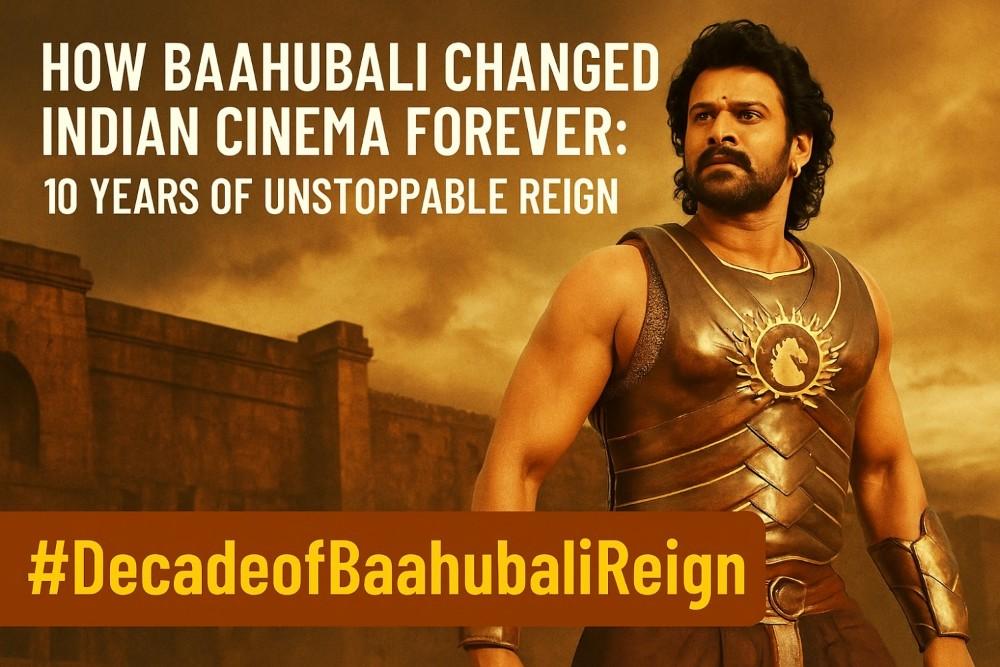A Decade of the Baahubali Phenomenon
It has been 10 years since Baahubali: The Beginning first hit the silver screens, and the internet is buzzing with the hashtag #DecadeofBaahubaliReign. This milestone is more than just an anniversary—it marks a revolutionary moment in Indian cinema. Directed by S.S. Rajamouli and led by Prabhas, this cinematic masterpiece redefined what was possible in Indian filmmaking, both in terms of scale and impact.
Today, as fans worldwide relive the grandeur of Baahubali, it’s time to look back at how this franchise carved its name in cinematic history and why its legacy still dominates conversations.
The Birth of a Legend: Baahubali’s Groundbreaking Vision
When Baahubali: The Beginning released in July 2015, Indian cinema had never seen anything quite like it. From jaw-dropping visuals to an emotionally layered storyline, the movie offered a theatrical experience that blended historical drama, action, and fantasy on an epic scale. The film introduced audiences to the fictional kingdom of Mahishmati, where honor, betrayal, and valor collide in a tale that spans generations.
The vision behind Baahubali was bold. S.S. Rajamouli wanted to create not just a movie, but a world. Every scene was meticulously designed—from vast battlefield sequences to intricately detailed palaces. It set a new benchmark for Indian films, with special effects and production quality that rivaled global standards.
A Pan-India Revolution: Language No Bar
One of the major reasons Baahubali became a cultural phenomenon was its ability to cross linguistic and regional barriers. Initially filmed in Telugu and Tamil, the film was simultaneously dubbed and released in multiple languages including Hindi, Malayalam, Kannada, and more. This made Baahubali one of the first truly pan-India films—a model that has since become a blueprint for success with movies like KGF, Pushpa, and RRR following in its footsteps.
By appealing to audiences across India, Baahubali shattered the long-standing myth that regional cinema couldn’t dominate the national or global market.
Why Did Kattappa Kill Baahubali? The Question That Changed Marketing Forever
The biggest cliffhanger in Indian film history—“Why did Kattappa kill Baahubali?”—was more than a plot twist. It became a nationwide obsession, trending for two years until Baahubali 2: The Conclusion released in 2017. This single question not only kept the audience invested but also redefined film marketing in India.
The film’s promotions tapped into audience curiosity like never before. Social media campaigns, teaser trailers, behind-the-scenes content, and fan theories generated massive engagement. The Baahubali team pioneered digital-first strategies that are now standard in the industry.
Box Office Tsunami: Records Broken Across the Board
From the moment it opened, Baahubali dominated the box office. The Beginning collected over ₹600 crore worldwide, becoming the highest-grossing Indian film at the time. Its sequel, Baahubali 2: The Conclusion, took it even further—raking in a staggering ₹1,782 crore globally. It held the record for the highest-grossing Indian film for years, only recently rivaled by global hits like RRR and Pathaan.
These numbers weren’t just a commercial victory. They signaled a global shift in how Indian films were perceived—both by domestic audiences and international markets.
Star-Making Performances and Timeless Characters
Prabhas, who played both Amarendra and Mahendra Baahubali, became a household name across India. His commitment to the role—spending over five years dedicated to just these two films—paid off with a performance that felt both grand and deeply personal.
Rana Daggubati’s menacing portrayal of Bhallaladeva, Anushka Shetty’s regal Devasena, and Sathyaraj’s unforgettable Kattappa created characters that became cultural icons. Their performances anchored the film’s emotional weight and contributed to its long-lasting appeal.
Behind the Scenes: Years of Craftsmanship
What many may not know is the sheer effort that went into crafting Baahubali. The production involved over 2,000 crew members, cutting-edge CGI, and extensive location shoots including Bulgaria and Ramoji Film City in Hyderabad. Costume designers, set decorators, VFX artists, and fight choreographers all worked together to bring Rajamouli’s vision to life.
This kind of investment—both in time and resources—was unprecedented in Indian cinema and showed what was possible when filmmakers dared to dream big.
Cultural Legacy: More Than Just a Movie
Even a decade later, Baahubali’s influence is still felt. It is studied in film schools, referenced in pop culture, and continues to inspire content creators across platforms. The film’s soundtrack remains popular, and scenes like the Shivling lift and the waterfall reveal are etched into collective memory.
Moreover, the franchise spurred merchandise, comic books, a Netflix prequel series, and even live concerts with orchestras playing the film’s score. Baahubali wasn’t just a film—it was a movement.
Why #DecadeofBaahubaliReign Matters Today
The trending hashtag #DecadeofBaahubaliReign isn’t just about nostalgia. It’s a celebration of the moment Indian cinema evolved. Baahubali showed that Indian stories, when told with ambition and technical finesse, could compete with the best in the world.
This 10-year milestone is a reminder of how far the industry has come—and how much of that journey began with a filmmaker who asked “What if we dreamed bigger?”
Conclusion: The Legacy Lives On
As we celebrate 10 years of Baahubali, it’s clear that this franchise did more than entertain—it inspired. It raised the bar, created a blueprint for cinematic success, and united audiences across languages and regions. The Baahubali reign may have started a decade ago, but its impact is still growing.
From a historic cliffhanger to global box office glory, Baahubali changed Indian cinema forever. And as the world continues to chant Baahubali, the legacy marches on.
